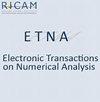初边值问题的无矩阵Legendre谱法
IF 1.1
4区 数学
Q3 MATHEMATICS, APPLIED
引用次数: 1
摘要
我们研究了描述波传播的时变偏微分方程的数值方法,主要应用于由时变薛定谔方程(TDSE)控制的量子动力学问题。我们考虑了空间逼近和时间步进两种方法。在大多数情况下,TDSE的数值解比求解双曲波动方程更具挑战性。这主要是因为TDSE的色散关系使其对色散误差非常敏感,并且对标准显式时间步进方案推导出严格的时间步长限制。TDSE也经常是高维的,在这里标准方法是难以处理的。对色散误差的敏感性使光谱方法对TDSE具有优势。除了一篇纳入的论文外,我们在所有论文中都使用了光谱或伪光谱方法。在第三篇论文中,我们改进并分析了傅里叶伪谱方法用于有限正则性问题的准确性,在第五篇论文中,我们构造了一个无矩阵谱方法用于具有非平凡边界条件的问题。由于其刚度,TDSE通常使用指数时间积分来求解。在本文中,我们使用指数算子分裂和Krylov子空间方法。本文严格证明了力梯度算子分裂方法的收敛性。使高维问题在计算上易于处理的一种方法是低秩近似。在第六篇论文中,我们证明了一种动态低秩逼近的分裂方法对于逼近于零的奇异值具有鲁棒性,这种情况由于意味着逼近空间的强曲率而难以处理。本文章由计算机程序翻译,如有差异,请以英文原文为准。
A MATRIX-FREE LEGENDRE SPECTRAL METHOD FOR INITIAL-BOUNDARY VALUE PROBLEMS
We study numerical methods for time-dependent partial differential equations describing wave propagation, primarily applied to problems in quantum dynamics governed by the time-dependent Schrodinger equation (TDSE). We consider both methods for spatial approximation and for time stepping. In most settings, numerical solution of the TDSE is more challenging than solving a hyperbolic wave equation. This is mainly because the dispersion relation of the TDSE makes it very sensitive to dispersion error, and infers a stringent time step restriction for standard explicit time stepping schemes. The TDSE is also often posed in high dimensions, where standard methods are intractable.The sensitivity to dispersion error makes spectral methods advantageous for the TDSE. We use spectral or pseudospectral methods in all except one of the included papers. In Paper III we improve and analyse the accuracy of the Fourier pseudospectral method applied to a problem with limited regularity, and in Paper V we construct a matrix-free spectral method for problems with non-trivial boundary conditions. Due to its stiffness, the TDSE is most often solved using exponential time integration. In this thesis we use exponential operator splitting and Krylov subspace methods. We rigorously prove convergence for force-gradient operator splitting methods in Paper IV. One way of making high-dimensional problems computationally tractable is low-rank approximation. In Paper VI we prove that a splitting method for dynamical low-rank approximation is robust to singular values in the approximation approaching zero, a situation which is difficult to handle since it implies strong curvature of the approximation space.
求助全文
通过发布文献求助,成功后即可免费获取论文全文。
去求助
来源期刊
CiteScore
2.10
自引率
7.70%
发文量
36
审稿时长
6 months
期刊介绍:
Electronic Transactions on Numerical Analysis (ETNA) is an electronic journal for the publication of significant new developments in numerical analysis and scientific computing. Papers of the highest quality that deal with the analysis of algorithms for the solution of continuous models and numerical linear algebra are appropriate for ETNA, as are papers of similar quality that discuss implementation and performance of such algorithms. New algorithms for current or new computer architectures are appropriate provided that they are numerically sound. However, the focus of the publication should be on the algorithm rather than on the architecture. The journal is published by the Kent State University Library in conjunction with the Institute of Computational Mathematics at Kent State University, and in cooperation with the Johann Radon Institute for Computational and Applied Mathematics of the Austrian Academy of Sciences (RICAM).

 求助内容:
求助内容: 应助结果提醒方式:
应助结果提醒方式:


